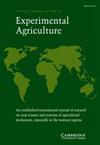Does inoculation with native rhizobia enhance nitrogen fixation and yield of cowpea through legume-based intercropping in the northern mountainous areas of Vietnam?
IF 1.9
4区 农林科学
Q1 Agricultural and Biological Sciences
引用次数: 3
Abstract
Abstract In the Northern mountainous region of Vietnam, cassava–cowpea intercropping system has been widely promoted with support from the local agricultural department. However, cowpea yield is often limited because of a low Biological Nitrogen Fixation (BNF) activity due to its low natural nodulation and lack of available effective Rhizobium products. The aim of this study was to identify the most effective native rhizobia isolate nodulating cowpea with the potential to increase BNF and yield of cowpea. A greenhouse experiment was initially conducted with five treatments: three native rhizobia isolates (CMBP037, CMBP054, and CMBP065); a control (no inoculation and no N application); and N+ (no inoculation, application of N as KNO3). Field inoculations were carried out and the treatments were as follows: a control (no inoculation); CMBP (037+054) – a mixture of strains from Mau Dong; CMBP065 strain from Cat Thinh. CMBP054 and CMBP065 had the highest nodulation in the greenhouse (46.4 and 60.7 nodules plant−1, respectively) and were rated as effective with symbiotic efficiency (SEF) of 54.56 and 55.73%, respectively. In the field, CMBP (037+054) recorded significantly higher nodulation (19.4 nodules plant−1) than the control (11.7 nodules plant−1). CMBP (037+054) also increased cowpea shoot dry weight, shoot N, and yield by 28.6, 4.9, and 10.5%, respectively, compared to the uninoculated control. This effect was slope dependent (statistically significant in moderate and steep slope, not with gentle slope). Besides, the high expansion rate of intercropping with cowpea showed the high adoption level of these agroecological practices by local farmers. This study reveals the potential of native rhizobia inoculation to enhance soil fertility and sustainable agriculture in the Northern mountainous region of Vietnam and proposes enhanced efforts to promote the availability and utilization of effective inoculants for cowpea.在越南北部山区,接种本地根瘤菌是否能通过豆科作物间作提高豇豆的固氮和产量?
摘要在越南北部山区,木薯-豇豆间作系统在当地农业部门的支持下得到了广泛推广。然而,豇豆的产量往往受到限制,因为其天然结瘤率低,缺乏有效的根瘤菌产品,生物固氮(BNF)活性低。本研究的目的是鉴定最有效的本地根瘤菌分离株,该分离株具有提高豇豆BNF和产量的潜力。最初用五种处理进行了温室试验:三种本地根瘤菌分离株(CMBP037、CMBP054和CMBP065);对照(不接种和不施氮);和N+(不接种、以KNO3形式施用N)。进行田间接种,处理如下:对照(不接种);CMBP(037+054)-毛洞菌株的混合物;来自Cat Thinh的CMBP065菌株。CMBP054和CMBP065在温室中结瘤率最高(分别为46.4和60.7个根瘤植物−1),被评为有效,共生效率(SEF)分别为54.56%和55.73%。在田间,CMBP(037+054)的结瘤率(19.4个根瘤植物−1)显著高于对照(11.7个根瘤植株−1)。与未接种对照相比,CMBP(037+054)还使豇豆地上部干重、地上部氮和产量分别增加了28.6%、4.9%和10.5%。这种影响与坡度有关(在中等坡度和陡坡上具有统计学意义,而在缓坡上不具有统计学意义)。此外,与豇豆间作的高扩展率表明当地农民对这些农业生态实践的采用水平很高。本研究揭示了本地根瘤菌接种在提高越南北部山区土壤肥力和可持续农业方面的潜力,并建议加大力度促进豇豆有效接种剂的可用性和利用。
本文章由计算机程序翻译,如有差异,请以英文原文为准。
求助全文
约1分钟内获得全文
求助全文
来源期刊

Experimental Agriculture
农林科学-农艺学
CiteScore
2.50
自引率
6.20%
发文量
29
审稿时长
24 months
期刊介绍:
With a focus on the tropical and sub-tropical regions of the world, Experimental Agriculture publishes the results of original research on field, plantation and herbage crops grown for food or feed, or for industrial purposes, and on farming systems, including livestock and people. It reports experimental work designed to explain how crops respond to the environment in biological and physical terms, and on the social and economic issues that may influence the uptake of the results of research by policy makers and farmers, including the role of institutions and partnerships in delivering impact. The journal also publishes accounts and critical discussions of new quantitative and qualitative methods in agricultural and ecosystems research, and of contemporary issues arising in countries where agricultural production needs to develop rapidly. There is a regular book review section and occasional, often invited, reviews of research.
 求助内容:
求助内容: 应助结果提醒方式:
应助结果提醒方式:


